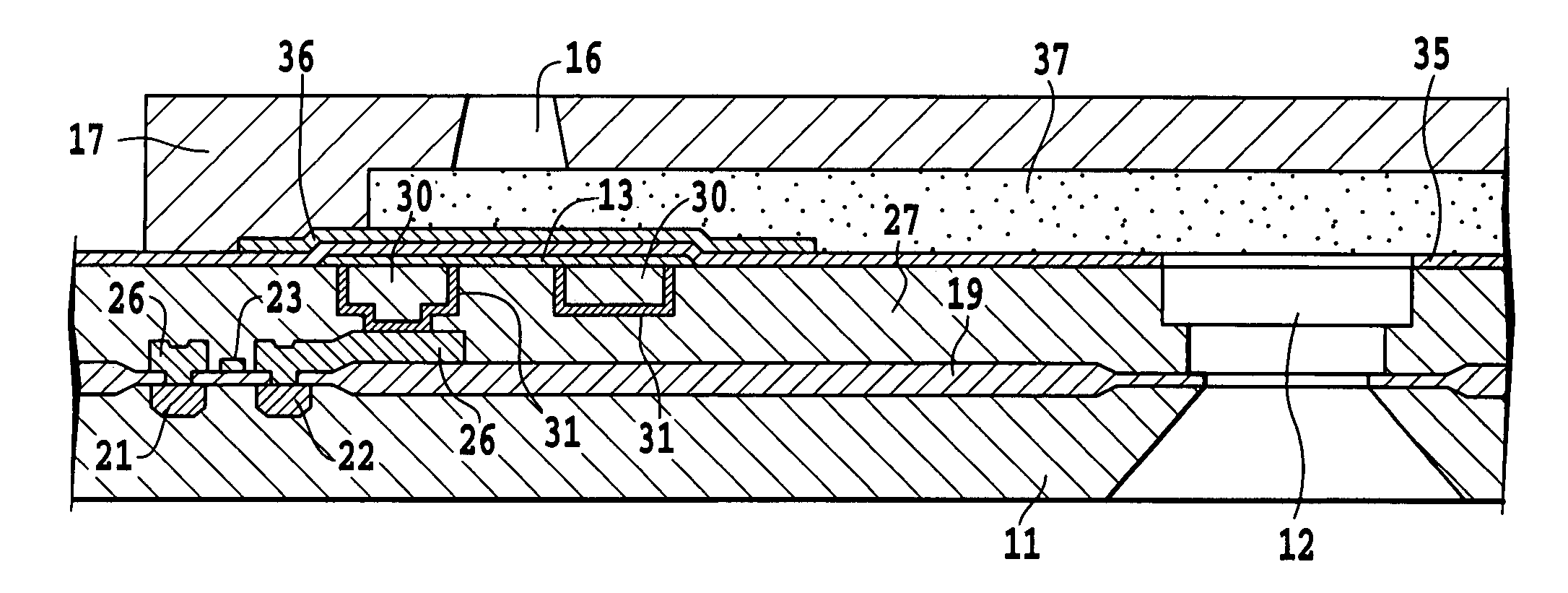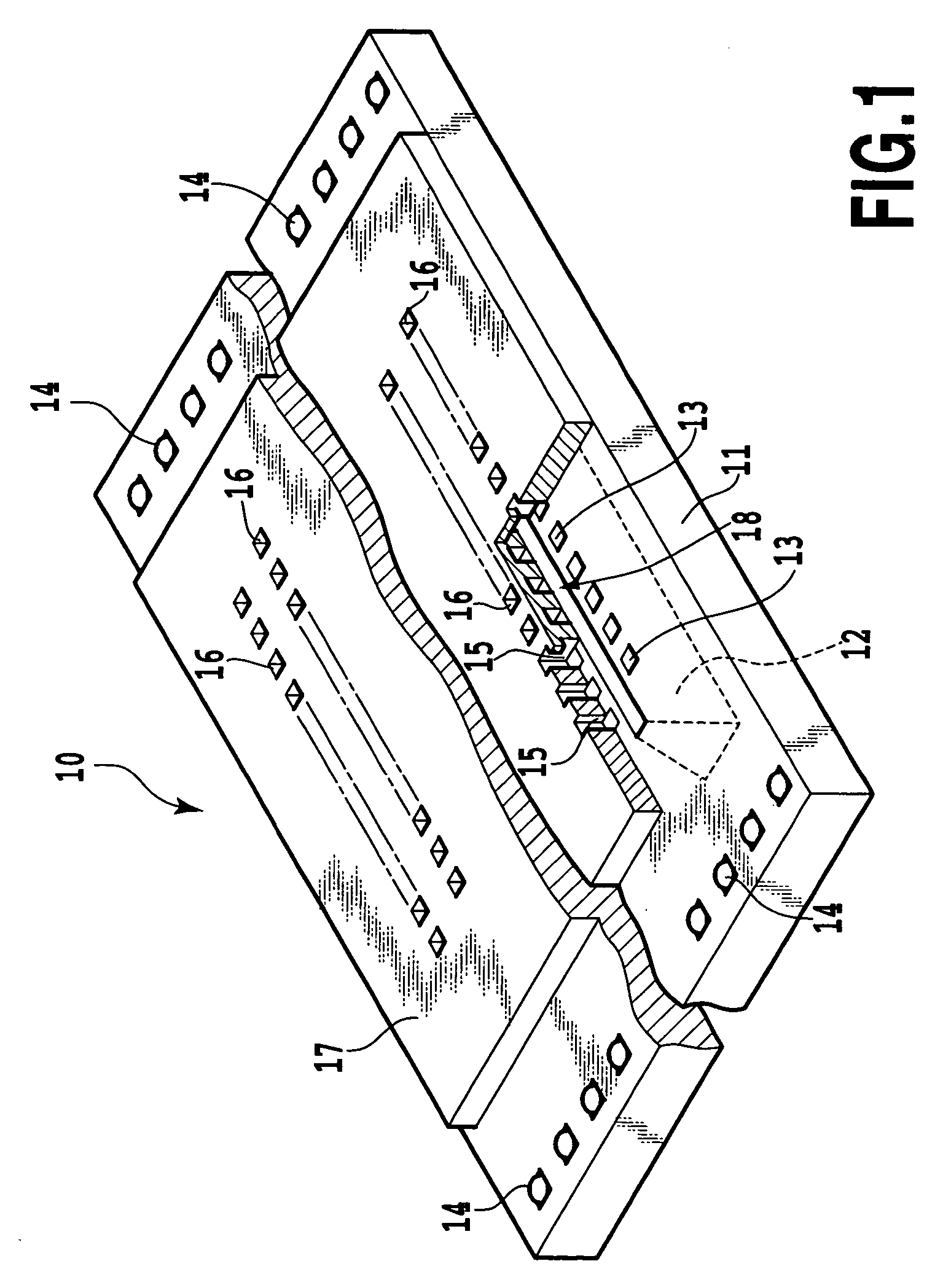Method for manufacturing liquid ejection head
- Summary
- Abstract
- Description
- Claims
- Application Information
AI Technical Summary
Benefits of technology
Problems solved by technology
Method used
Image
Examples
first embodiment
[0070]A structure of a printing element substrate 10 in a printing head is shown in FIG. 1. In the printing element substrate 10, ejection energy generators, liquid chambers, ejection openings or others are formed on a silicon substrate 11 of 0.5 to 1 mm thick.
[0071]In the silicon substrate 11, a liquid supply port 12 of an elongate hole shape is formed to pass through the same. On opposite sides of the liquid supply port 12, a plurality of electro-thermal transducers 13 are arranged at a predetermined gap in a lengthwise direction of the liquid supply port 12 while shifting half a pitch from one on the opposite side, whereby the ejection energy generator is constituted. In the silicon substrate 11, other than the electro-thermal transducers 13, there are electrode terminals 14 for electrically connecting the electro-thermal transducers 13 to a printer body and electric wiring not shown made, for example, of aluminum, both of which are formed by the deposition technique. A drive si...
second embodiment
[0091]Such the present invention will be described with reference to FIGS. 10 to 13, wherein parts having the same functions as in the preceding embodiment are indicated by the same reference numerals and the redundant explanation thereof are eliminated. That is, while the etching-stop layer 32 is solely brought into contact with the upper end surface of the sacrificial layer 20 in the preceding embodiment, the etching-stop layer 32 extends to the SiO2 layer 19 to cover the sacrificial layer 20 according to this embodiment (see FIG. 10). Thereby, it is possible to completely shut the insulating layer 27 from the sacrificial layer 20.
[0092]Thus, in a state shown in FIG. 10, when the liquid supply port 12 reaching the sacrificial layer 20 is formed by the anisotropic etching carried out on the rear surface of the silicon substrate 11, the invasion of the etching liquid upon the insulating layer 27 is completely prevented since the insulating layer 27 is separated from the sacrificial ...
third embodiment
[0095]Then, the present invention is described with reference to FIGS. 14 to 18. In this case, to avoid the redundancy, the liquid supply port 12 will be solely described. In these drawings, parts having the same functions as in the preceding embodiments are indicated by the same reference numerals. That is, after the SiO2 layer 19 is formed on the silicon substrate 11 and the PSG layer 38 is formed thereon by the cold CVD method, portions of the SiO2 layer 19 and the PSG layer 38 in which the liquid supply port 12 is to be formed are simultaneously removed by the etching to form an opening 39, to which is exposed the silicon substrate 11 (see FIG. 14).
[0096]Next, the electrode wiring layer 26 of aluminum-copper alloy (see FIG. 4) is formed on the PSG layer 38 and patterned to have a predetermined shape. At this stage, the driver elements such as a drive transistor or others described hereinabove is completed.
[0097]Then, the SiO2 insulating layer 27 of 1.0 to 1.8 μm thick is deposit...
PUM
| Property | Measurement | Unit |
|---|---|---|
| Pressure | aaaaa | aaaaa |
| Energy | aaaaa | aaaaa |
| Tensile stress | aaaaa | aaaaa |
Abstract
Description
Claims
Application Information
 Login to View More
Login to View More - R&D
- Intellectual Property
- Life Sciences
- Materials
- Tech Scout
- Unparalleled Data Quality
- Higher Quality Content
- 60% Fewer Hallucinations
Browse by: Latest US Patents, China's latest patents, Technical Efficacy Thesaurus, Application Domain, Technology Topic, Popular Technical Reports.
© 2025 PatSnap. All rights reserved.Legal|Privacy policy|Modern Slavery Act Transparency Statement|Sitemap|About US| Contact US: help@patsnap.com



